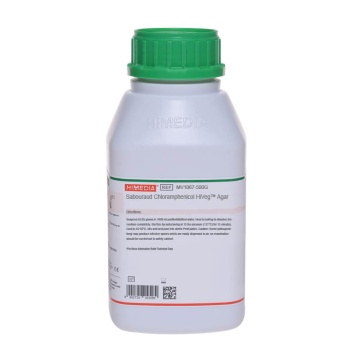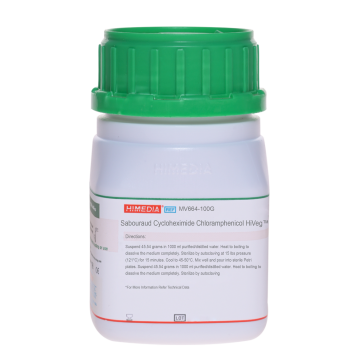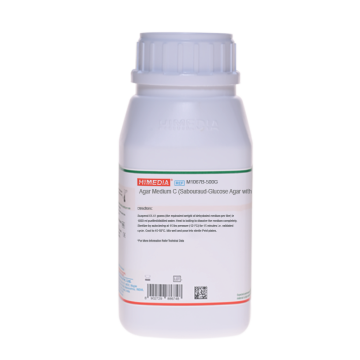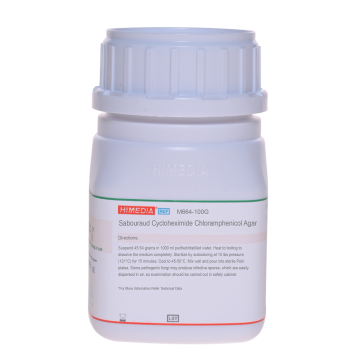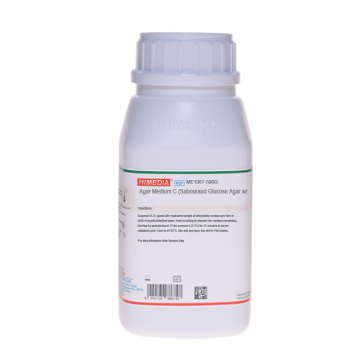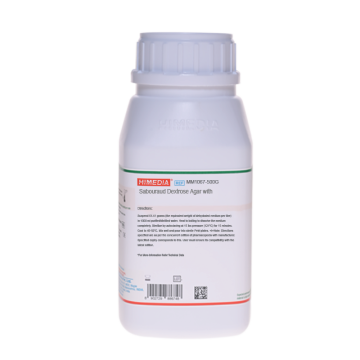 Your enquiry has been submitted
Your enquiry has been submitted
Modified Sabourauds Chloramphenicol Agar
Intended Use
A selective medium recommended for the isolation of all species of yeast and dermatophytes.
Composition**
| Ingredients | g/ L |
|---|---|
| Peptone | 3.000 |
| Tryptone | 3.000 |
| Soya peptone | 3.000 |
| Yeast extract | 2.000 |
| Malt extract | 1.000 |
| Dextrose (Glucose) | 19.000 |
| Potassium dihydrogen phosphate | 0.500 |
| Disodium hydrogen phosphate | 0.500 |
| Chloramphenicol | 0.500 |
| Agar | 13.000 |
Final pH ( at 25°C) 6.4±0.2
**Formula adjusted, standardized to suit performance parameters
Directions
Suspend 45.5 grams in 1000 ml purified/distilled water. Heat to boiling to dissolve the medium completely. Sterilize by autoclaving at ∆ 118°C for 15 minutes. Avoid overheating. Cool to 45-50°C. Mix well and pour into sterile Petri plates.
∆ corresponds to 12 lbs pressure.
Principle And Interpretation
Sabouraud Dextrose Agar is a general purpose medium devised by Sabouraud for the cultivation of dermatophytes (1). The low pH is favorable for the growth of fungi and dermatophytes, and slightly inhibitory to contaminating bacteria from clinical specimens (2,3).
The addition of antibiotics, such as chloramphenicol (a broad spectrum antibiotics) is a modification designed to increase bacterial inhibition (3,4). Peptone, tryptone, yeast extract, soya peptone and malt extract provide nitrogenous compounds. Dextrose provides an energy source. Chloramphenicol inhibits a wide range of gram-positive and gram-negative bacteria making the medium selective for fungi. Phosphate buffers the medium.
Type of specimen
Clinical samples: skin scrapings; Food and dairy samples
Specimen Collection and Handling
For clinical samples follow appropriate techniques for handling specimens as per established guidelines (5,6).
For food and dairy samples, follow appropriate techniques for sample collection and processing as per guidelines (7,8). After use, contaminated materials must be sterilized by autoclaving before discarding.
Warning and Precautions
In Vitro diagnostic Use. For professional use only. Read the label before opening the container. Wear protective gloves/protective clothing/eye protection/face protection. Follow good microbiological lab practices while handling specimens and culture. Standard precautions as per established guidelines should be followed while handling clinical specimens. Safety guidelines may be referred in individual safety data sheets.
Limitations
- Certain pathogenic fungi may show poor growth on this medium.
- Presence of chloramphenicol may inhibit certain pathogenic fungi.
- Overheating of the medium may result in low productivity and softening of gel.
- Individual organisms differ in their growth requirement and may show variable growth patterns on the medium.
- Each lot of the medium has been tested for the organisms specified on the COA. It is recommended to users to validate the medium for any specific microorganism other than mentioned in the COA based on the user’s unique requirement.
Performance and Evaluation
Performance of the medium is expected when used as per the direction on the label within the expiry period when stored at recommended temperature.
Quality Control
Appearance: Cream to yellow homogeneous free flowing powder
Gelling: Firm, comparable with 1.3% Agar gel
Colour and Clarity of prepared medium: Light amber coloured clear to slightly opalescent gel forms in Petri plates
Reaction: Reaction of 4.55% w/v aqueous solution at 25°C. pH : 6.4±0.2
pH: 6.20-6.60
Cultural Response: Cultural characteristics observed after an incubation at 25-30°C for 48-72 hours (for Trichophyton species incubate for 7 days).
| Organism | Inoculum (CFU) | Growth | Recovery |
|---|---|---|---|
| Trichophyton rubrum ATCC 28191 | 50-100 | luxuriant | |
| #Aspergillus brasiliensis ATCC 16404 (00053*) | 50-100 | luxuriant | |
| Candida albicans ATCC 10231 (00054*) | 50-100 | luxuriant | >=50% |
| Escherichia coli ATCC 25922 (00013*) | >=104 | inhibited | 0% |
| Lactobacillus casei ATCC 9595 | >=104 | inhibited | 0% |
| Saccharomyces cerevisiae ATCC 9763 (00058*) | 50-100 | luxuriant | >=50% |
Key : *Corresponding WDCM numbers. # - Formerly known as Aspergillus niger
Storage and Shelf Life
Store the dehydrated powder and prepared medium on receipt between 15-30°C in a tightly closed container. Use before expiry date on the label. On opening, product should be properly stored dry, after tightly capping the bottle in order to prevent lump formation due to the hygroscopic nature of the product. Improper storage of the product may lead to lump formation. Store in dry ventilated area protected from extremes of temperature and sources of ignition. Seal the container tightly after use. Product performance is best if used within stated expiry period.
Disposal
User must ensure safe disposal by autoclaving and/or incineration of used or unusable preparations of this product. Follow established laboratory procedures in disposing of infectious materials and material that comes into contact with clinical sample must be decontaminated and disposed of in accordance with current laboratory techniques (5,6).
Reference
- Sabouraud K., 1892, Ann. Dermatol. Syphilol., 3:106
- Ajello L., Georg L. K., Kaplan W. and Kaufman L., 1963, Laboratory Manual for Medical Mycology, DHEW Publication No. 994, US Govt. Printing Office, Washington, D.C.
- Kwon-Chung and Bennet, 1992, Medical Mycology, Lea and Febiger, Philadelphia, P
- Murray P. R., Baron E. J., Pfaller M. A., Tenover F.C. and Yolken R. H., (Ed), 1995, Manual of Clinical Microbiology, 6th Ed., American Society for Microbiology, Washington, D.C.
- Isenberg, H.D. Clinical Microbiology Procedures Handbook 2nd Edition
- Jorgensen, J.H., Pfaller, M.A., Carroll, K.C., Funke, G., Landry, M.L., Richter, S.S and Warnock., D.W. (2015) Manual of Clinical Microbiology, 11th Edition. Vol. 1.
- Salfinger Y., and Tortorello M.L. Fifth (Ed.), 2015, Compendium of Methods for the Microbiological Examination of Foods, American Public Health Association, Washington, D.C.
- Wehr H. M. and Frank J. H., 2004, Standard Methods for the Microbiological Examination of Dairy Products, 17th Ed., APHA Inc., Washington, D.C.
| Product Name | Modified Sabourauds Chloramphenicol Agar |
|---|---|
| SKU | M1681 |
| Product Type | Regular |
| Physical Form | Powder |
| Origin | Animal |
| Packaging type | HDPE |
| References | 1. Sabouraud K., 1892, Ann. Dermatol. Syphilol., 3:1061. |
| Customized Product Available | No |




